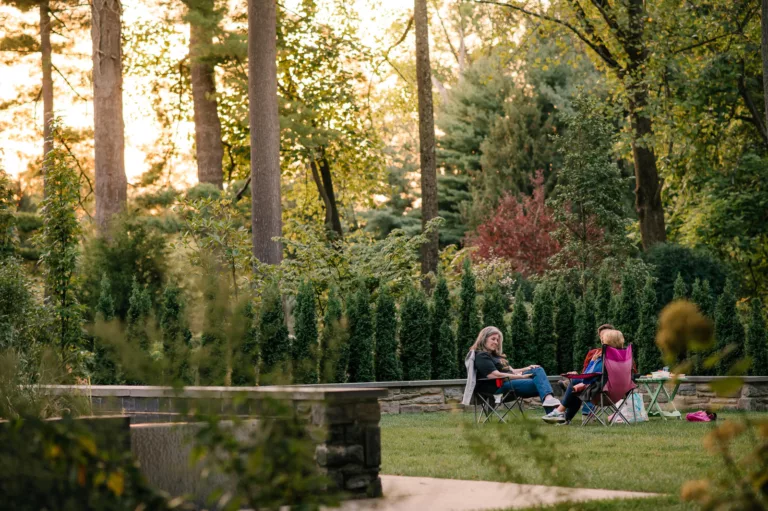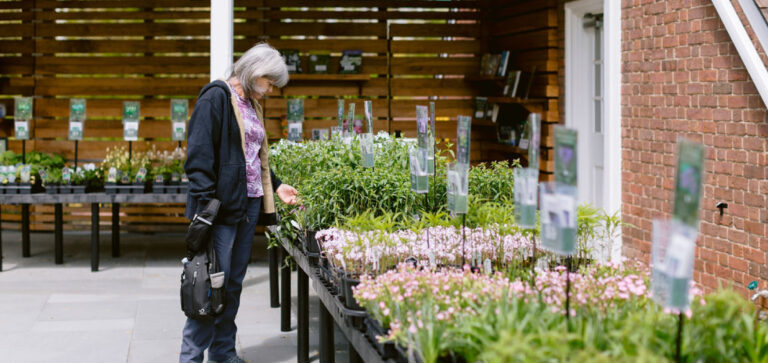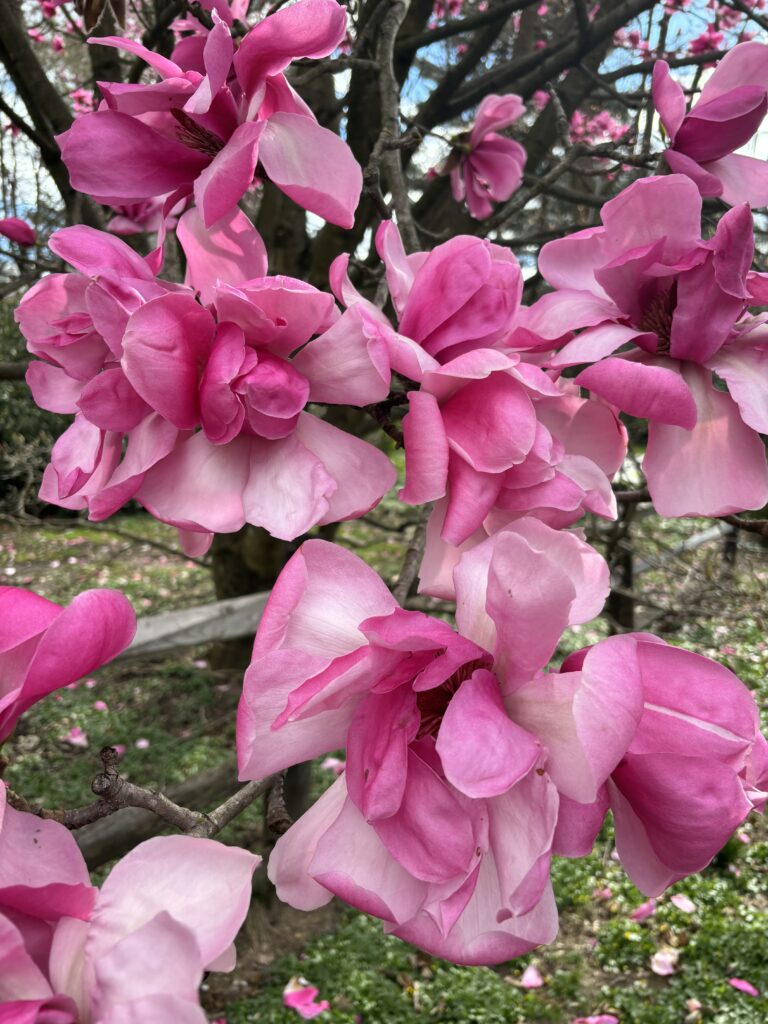In 1876, Philadelphia hosted the Centennial International Exposition to celebrate the 100th anniversary of American Independence. Japan, which had recently opened its borders, participated in the international world’s fair on a large scale for the first time. As part of its exhibition, Japan built two traditional Japanese structures and the first Japanese garden in North America at the current location of Shofuso Japanese House and Garden in West Fairmount Park. The exhibition sparked interest throughout the region and the nation in Japanese aesthetics, and that influence lives on today in several Greater Philadelphia gardens. The following gardens can be visited within a single day.
Stop 1: Shofuso Japanese House and Garden
Lansdowne Drive and Horticultural Drive, Philadelphia, Pennsylvania
Plan your visit and confrim hours of operation at japanphilly.org/shofuso.

➔ Constructed in Japan in the 1950s using historic techniques, Shofuso is a 17th century style Japanese villa that is an architectural marvel. The house was first exhibited at New York’s Museum of Modern Art as part of a “House at the Museum” exhibition, and, following the exhibit, was moved to Philadelphia in 1958, next to the site of the first Japanese garden in North America from the 1876 Centennial Exposition. Shofuso features a hinoki bark roof, the only one of its kind outside of Japan, a tea house that is regularly used for tea ceremony education and demonstration, and the largest American collection of site-specific fusuma paintings by contemporary artist Hiroshi Senju.
➔ Landscape designer Tansai Sano designed Shofuso’s landscape plan, which includes three distinct gardens. The tsukiyama (hill and pond garden) is the most formal, with a hillside that includes a cutleaf maple, carefully pruned azalea bushes, and a tiered waterfall that empties into a pond stocked with world-class koi. The roji (a garden which surrounds the tea house) includes stepping-stone Shofuso’s Japanese Villa America’s Garden Capital Japanese and Asian Gardens 2 paths that cross over a stream, Japanese black pines, and hand-tied bamboo fences. Moving toward the tsubo-niwa (an urban courtyard garden), see a Japanese garden distilled down to its smallest elements: plantings of hostas and quince, stonework, and a bamboo deer-scare constructed by gardeners from Sorakuen, Shofuso’s sister garden in Kobe. Shofuso’s pond is home to a world class collection of koi fish that can be hand fed by visitors from a pond’s edge boat landing.
➔ Once a month during Shofuso’s season, students of the Urasenke Tea School of Philadelphia and the Omotesenke Tea School of Princeton present tea ceremony demonstrations that are open to the public. Enjoy a bowl of matcha tea and taste a seasonal sweet as you observe a tea ceremony. Tea ceremony is a ticketed event and advance registration is recommended; guests are welcome to enjoy the garden before and after the ceremony.
Stop 2: Chanticleer, a pleasure garden
786 Church Road, Wayne, Pennsylvania
Visit chanticleergarden.org to confirm hours of operation.

➔ The Chanticleer estate dates from the early 20thcentury, and was owned by Adolph Rosengarten, Sr., and his wife Christine as a country retreat. The family’s pharmaceutical firm would become part of Merck & Company in the 1920s. The estate features fourteen garden areas containing more than 7,000 plants, and is maintained by a team of seven horticulturalists. The garden is a study of textures and forms, where foliage trumps flowers, the gardeners lead the design, and even the drinking fountains are sculptural. It is a garden of pleasure and learning, relaxing yet filled with ideas to take home.
➔ The Asian Woods at Chanticleer is not based on a particular garden style, but rather features plants native to China, Japan, and Korea in an American woodland-style design. Visitors to the garden travel over bridges and down decorative paths inlaid with wood and stone through bamboo groves, mondo grass, and hostas. In season, spot magnolias, hydrangeas, and chrysanthemums in bloom. Nearby the Asian Woods, the pond garden features a pond lush with water lilies – as well as friendly koi.
➔ Chanticleer does not have a garden cafe, but guests are encouraged to bring a picnic or visit a nearby restaurant in Wayne, PA before or after your visit.
Stop 3: Morris Arboretum of the University of Pennsylvania
100 E. Northwestern Avenue, Philadelphia, Pennsylvania
Open daily, hours vary with the season. Visit morrisarboretum.org to plan your visit.

➔ The official arboretum of the Commonwealth of Pennsylvania, the Morris Arboretum of the University of Pennsylvania is a historic public garden and educational institution. Since its inception in 1887 as Compton, the summer home of John and Lydia Morris, it has become a resource for horticulture and botany. John and Lydia traveled widely in America, Asia, and Europe bringing ideas, artwork, crafts and plants back to Compton, and were one of the first American gardens to adopt the Victorian style of borrowing elements from other cultures. In 1913, The Philadelphia Ledger wrote about the Asian aspects of the Morrises’ garden as, “…an object lesson in the adaptation of foreign ideas to American conditions.”
➔ Morris Arboretum features Japanese style gardens, the oldest still existing in the region. The Hill Garden (or tsukiyama-niwa) was built in 1905 by a designer named Mr. Muto, and features some original garden specimens. The Japanese Overlook garden, which was built in 1912 with assistance from Mudo, melds elements of an English rock garden and a Japanese garden. Victorian elements including a mountain-like trail with zigzag paths, metal railing, and flowering plants blend with Japanese style rockwork pine trees, moon lanterns, and Fudo stones. Today mature Japanese maples, conifers, and ericaceous (acid-loving plants) create a beautiful garden experience.
➔ The Compton Cafe is the official cafe of the Morris Arboretum, and is open to the public from April through October. Located directly behind the Widener Visitor Center, the cafe offers fresh, locally sourced gourmet cuisine. Food may be pre-ordered in advance.
Additional Recommendations Nearby
➔ For more Asian garden inspiration, visit the Haverford College Arboretum, which is free and open from dawn to dusk every day. After viewing the Denis Asian Garden and the Teaf Memorial Zen-style Garden, located near the college’s Dining Center, take a walk along the 2.2-mile Nature Trail that spans the campus perimeter.
➔ Enjoy Japanese curry, okonomiyaki, and udon at Maido! in Ardmore, PA. Watch chefs cook as you eat at the lunch counter, then grab a shopping cart and stock up on Japanese cooking essentials and treats in Maido’s grocery store.
➔ From mid-March to mid-April, Philadelphia bursts into white and pink cherry blossoms. Since the 1990s, the Japan America Society of Greater Philadelphia has led an effort to plant flowering Japanese cherry trees along the banks of the Schuylkill and throughout Fairmount Park. The Fairmount Park Horticulture Center, which is home to the Subaru Cherry Blossom Festival of Greater Philadelphia, features a cherry blossom alee, and nearby spots on Kelly Drive, Martin Luther King, Jr. Drive, and Belmont Plateau are lush in flowers.







